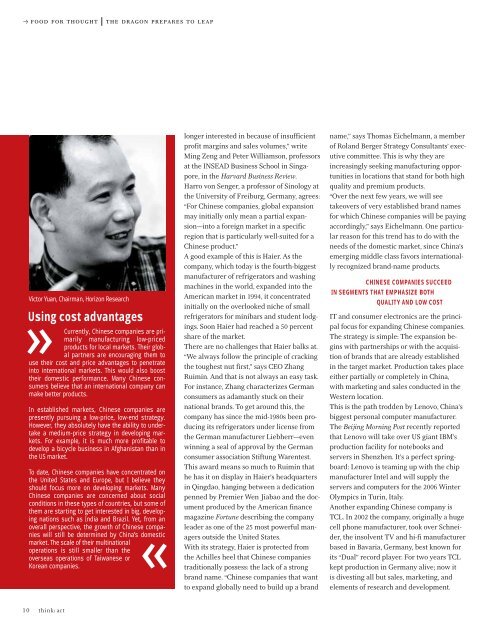issue 1 - Roland Berger
issue 1 - Roland Berger
issue 1 - Roland Berger
You also want an ePaper? Increase the reach of your titles
YUMPU automatically turns print PDFs into web optimized ePapers that Google loves.
p food for thought<br />
the dragon prepares to leap<br />
Victor Yuan, Chairman, Horizon Research<br />
»<br />
Using cost advantages<br />
Currently, Chinese companies are primarily<br />
manufacturing low-priced<br />
products for local markets. Their global<br />
partners are encouraging them to<br />
use their cost and price advantages to penetrate<br />
into international markets. This would also boost<br />
their domestic performance. Many Chinese consumers<br />
believe that an international company can<br />
make better products.<br />
In established markets, Chinese companies are<br />
presently pursuing a low-price, low-end strategy.<br />
However, they absolutely have the ability to undertake<br />
a medium-price strategy in developing markets.<br />
For example, it is much more profitable to<br />
develop a bicycle business in Afghanistan than in<br />
the US market.<br />
To date, Chinese companies have concentrated on<br />
the United States and Europe, but I believe they<br />
should focus more on developing markets. Many<br />
Chinese companies are concerned about social<br />
conditions in these types of countries, but some of<br />
them are starting to get interested in big, developing<br />
nations such as India and Brazil. Yet, from an<br />
overall perspective, the growth of Chinese companies<br />
will still be determined by China’s domestic<br />
market. The scale of their multinational<br />
operations is still smaller than the<br />
overseas operations of Taiwanese or<br />
Korean companies.<br />
»<br />
longer interested in because of insufficient<br />
profit margins and sales volumes,” write<br />
Ming Zeng and Peter Williamson, professors<br />
at the INSEAD Business School in Singapore,<br />
in the Harvard Business Review.<br />
Harro von Senger, a professor of Sinology at<br />
the University of Freiburg, Germany, agrees:<br />
“For Chinese companies, global expansion<br />
may initially only mean a partial expansion—into<br />
a foreign market in a specific<br />
region that is particularly well-suited for a<br />
Chinese product.”<br />
A good example of this is Haier. As the<br />
company, which today is the fourth-biggest<br />
manufacturer of refrigerators and washing<br />
machines in the world, expanded into the<br />
American market in 1994, it concentrated<br />
initially on the overlooked niche of small<br />
refrigerators for minibars and student lodgings.<br />
Soon Haier had reached a 50 percent<br />
share of the market.<br />
There are no challenges that Haier balks at.<br />
“We always follow the principle of cracking<br />
the toughest nut first,” says CEO Zhang<br />
Ruimin. And that is not always an easy task.<br />
For instance, Zhang characterizes German<br />
consumers as adamantly stuck on their<br />
national brands. To get around this, the<br />
company has since the mid-1980s been producing<br />
its refrigerators under license from<br />
the German manufacturer Liebherr—even<br />
winning a seal of approval by the German<br />
consumer association Stiftung Warentest.<br />
This award means so much to Ruimin that<br />
he has it on display in Haier’s headquarters<br />
in Qingdao, hanging between a dedication<br />
penned by Premier Wen Jiabao and the document<br />
produced by the American finance<br />
magazine Fortune describing the company<br />
leader as one of the 25 most powerful managers<br />
outside the United States.<br />
With its strategy, Haier is protected from<br />
the Achilles heel that Chinese companies<br />
traditionally possess: the lack of a strong<br />
brand name. “Chinese companies that want<br />
to expand globally need to build up a brand<br />
name,” says Thomas Eichelmann, a member<br />
of <strong>Roland</strong> <strong>Berger</strong> Strategy Consultants’ executive<br />
committee. This is why they are<br />
increasingly seeking manufacturing opportunities<br />
in locations that stand for both high<br />
quality and premium products.<br />
“Over the next few years, we will see<br />
takeovers of very established brand names<br />
for which Chinese companies will be paying<br />
accordingly,” says Eichelmann. One particular<br />
reason for this trend has to do with the<br />
needs of the domestic market, since China’s<br />
emerging middle class favors internationally<br />
recognized brand-name products.<br />
CHINESE COMPANIES SUCCEED<br />
IN SEGMENTS THAT EMPHASIZE BOTH<br />
QUALITY AND LOW COST<br />
IT and consumer electronics are the principal<br />
focus for expanding Chinese companies.<br />
The strategy is simple: The expansion begins<br />
with partnerships or with the acquisition<br />
of brands that are already established<br />
in the target market. Production takes place<br />
either partially or completely in China,<br />
with marketing and sales conducted in the<br />
Western location.<br />
This is the path trodden by Lenovo, China’s<br />
biggest personal computer manufacturer.<br />
The Beijing Morning Post recently reported<br />
that Lenovo will take over US giant IBM’s<br />
production facility for notebooks and<br />
servers in Shenzhen. It’s a perfect springboard:<br />
Lenovo is teaming up with the chip<br />
manufacturer Intel and will supply the<br />
servers and computers for the 2006 Winter<br />
Olympics in Turin, Italy.<br />
Another expanding Chinese company is<br />
TCL. In 2002 the company, originally a huge<br />
cell phone manufacturer, took over Schneider,<br />
the insolvent TV and hi-fi manufacturer<br />
based in Bavaria, Germany, best known for<br />
its “Dual” record player. For two years TCL<br />
kept production in Germany alive; now it<br />
is divesting all but sales, marketing, and<br />
elements of research and development.<br />
10<br />
think: act
















